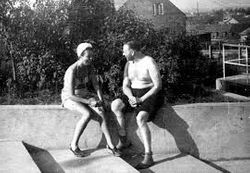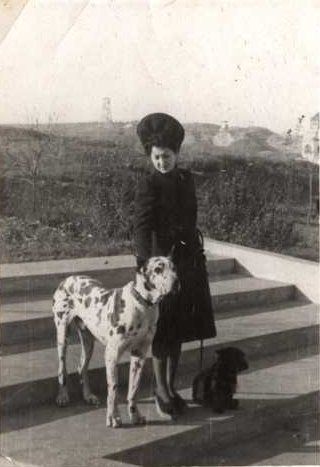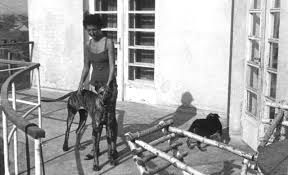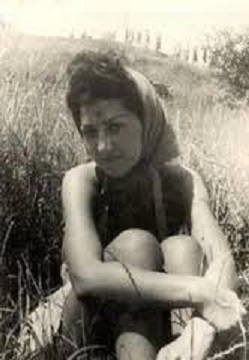Ruth was born to a German family in Silesia, Prussia, Germany (now a part of Poland), in which her father operated a driving school and had joined the Nazi Party in the early 1920s. In 1943, she volunteered as a secretary for the Wehrmacht (German Army) and was stationed in Plaszow, where she took a job as office assistant and typist for German businessman Oscar Schindler at his Plaszow Manufacturing Plant. There she met and was immediately smitten by Captain Amon Goeth. Schindler encouraged her to begin a relationship with Goeth, in the hopes of obtaining German Army contracts and to increasing his use of Jewish free labor from Goeth. She quickly fell in love with Goeth and moved in with him at his villa at the Concentration Camp, despite the fact that he had been twice married, and was currently still married to a woman living in Germany with whom he had three children. She remained with Goeth throughout the war, curbing some of his excesses with the Jews by threatening to cut him off from sex with her.
When the approaching Russian Army resulted in the camp being closed in 1944, she went with Goeth to the SS Base at Bad Tolz, Germany, where she continued to live openly with him. In January 1945, Goeth’s wife met them, discovering their relationship for the first time, and soon afterwards, Goeth received notice of a divorce. In April 1945, the American Army captured Bad Tolz and turned Goeth over to the Russian Army after determining he was wanted for war crimes in Poland; the Russians held a quick trial and hung Goeth in September 1946. In November 1945, Ruth gave birth to their daughter, Monika, in Bad Tolz, and she would raise her daughter to think of her father as having been killed in the war. Her daughter would learn the truth from her maternal grandmother when she was eleven. At the war’s end, Kalder moved to Munich where she raised her daughter, and where she remained for the rest of her life.
In Munich, Ruth worked alternately as a secretary, photo model, beautician, and as a bar maid. Monika would describe her mother as emotionally cold and her mother’s respect for her father as hypocritical because she would always tell people that he was killed in the war, not that he was hung as a war criminal.
In 1948, Ruth Kalder requested her legal name be changed to Goeth, testifying that it was only the chaos of war and the execution of the then divorced Amon Goeth that prevented them from being married. Amon Goeth’s father, Franz Goeth, testified that the two (Ruth and Amon) were betrothed, and so the request for the legal name change was granted. Ruth would keep a photo of Amon in her bedroom to honor his memory.
In early 1983, she was interviewed by writer Jon Blair, who was working in consultation with director Steven Spielberg, to produce what would become the movie “Schindler’s List.” She defended Goeth, saying that she regretted the time period, but that they never harmed anyone. Blair provided her transcripts of the war crimes trial for her to read, and at that time she learned the full truth as to Goeth’s activities at the KZ Camp in Plaszow. During the war, Goeth had personally executed several hundred people, and had caused the deaths of several tens of thousands, in his role as an officer in the SS Concentration Camp system. During the war, Goeth had also directed that siezed Jewish property be sold on the black market, with the proceeds given to him; while at Bad Tolz, Goeth had been charged by German authorities with theft of property (all Jewish property seized by German authorities was considered property of the Third Reich to be turned over for shipment to Germany; Goeth had stolen much of this property to sell on the Polish black market for his own gain). The day following this interview, Ruth Kalder took an overdose of sleeping pills after writing her daughter a suicide note. The letter ended with the words: “I just have loved you as you would love your own child. (signed) Your mother.” (Biography by Kit and Morgan Benson)
Ruth was born to a German family in Silesia, Prussia, Germany (now a part of Poland), in which her father operated a driving school and had joined the Nazi Party in the early 1920s. In 1943, she volunteered as a secretary for the Wehrmacht (German Army) and was stationed in Plaszow, where she took a job as office assistant and typist for German businessman Oscar Schindler at his Plaszow Manufacturing Plant. There she met and was immediately smitten by Captain Amon Goeth. Schindler encouraged her to begin a relationship with Goeth, in the hopes of obtaining German Army contracts and to increasing his use of Jewish free labor from Goeth. She quickly fell in love with Goeth and moved in with him at his villa at the Concentration Camp, despite the fact that he had been twice married, and was currently still married to a woman living in Germany with whom he had three children. She remained with Goeth throughout the war, curbing some of his excesses with the Jews by threatening to cut him off from sex with her.
When the approaching Russian Army resulted in the camp being closed in 1944, she went with Goeth to the SS Base at Bad Tolz, Germany, where she continued to live openly with him. In January 1945, Goeth’s wife met them, discovering their relationship for the first time, and soon afterwards, Goeth received notice of a divorce. In April 1945, the American Army captured Bad Tolz and turned Goeth over to the Russian Army after determining he was wanted for war crimes in Poland; the Russians held a quick trial and hung Goeth in September 1946. In November 1945, Ruth gave birth to their daughter, Monika, in Bad Tolz, and she would raise her daughter to think of her father as having been killed in the war. Her daughter would learn the truth from her maternal grandmother when she was eleven. At the war’s end, Kalder moved to Munich where she raised her daughter, and where she remained for the rest of her life.
In Munich, Ruth worked alternately as a secretary, photo model, beautician, and as a bar maid. Monika would describe her mother as emotionally cold and her mother’s respect for her father as hypocritical because she would always tell people that he was killed in the war, not that he was hung as a war criminal.
In 1948, Ruth Kalder requested her legal name be changed to Goeth, testifying that it was only the chaos of war and the execution of the then divorced Amon Goeth that prevented them from being married. Amon Goeth’s father, Franz Goeth, testified that the two (Ruth and Amon) were betrothed, and so the request for the legal name change was granted. Ruth would keep a photo of Amon in her bedroom to honor his memory.
In early 1983, she was interviewed by writer Jon Blair, who was working in consultation with director Steven Spielberg, to produce what would become the movie “Schindler’s List.” She defended Goeth, saying that she regretted the time period, but that they never harmed anyone. Blair provided her transcripts of the war crimes trial for her to read, and at that time she learned the full truth as to Goeth’s activities at the KZ Camp in Plaszow. During the war, Goeth had personally executed several hundred people, and had caused the deaths of several tens of thousands, in his role as an officer in the SS Concentration Camp system. During the war, Goeth had also directed that siezed Jewish property be sold on the black market, with the proceeds given to him; while at Bad Tolz, Goeth had been charged by German authorities with theft of property (all Jewish property seized by German authorities was considered property of the Third Reich to be turned over for shipment to Germany; Goeth had stolen much of this property to sell on the Polish black market for his own gain). The day following this interview, Ruth Kalder took an overdose of sleeping pills after writing her daughter a suicide note. The letter ended with the words: “I just have loved you as you would love your own child. (signed) Your mother.” (Biography by Kit and Morgan Benson)
Gravesite Details
Buried in her mother's plot.
Family Members
Sponsored by Ancestry
Advertisement
Advertisement







